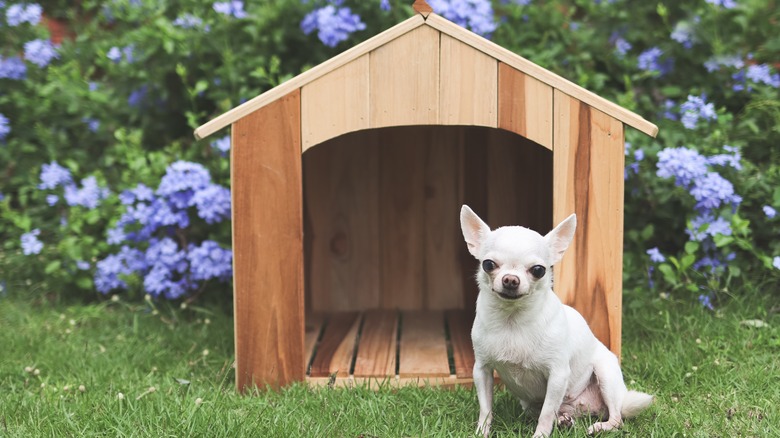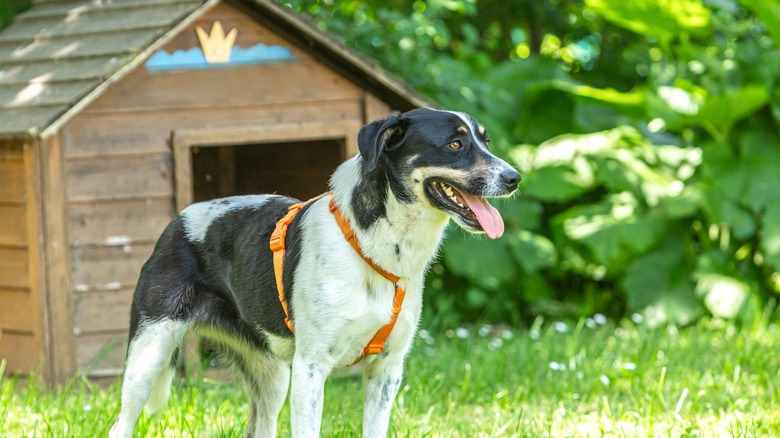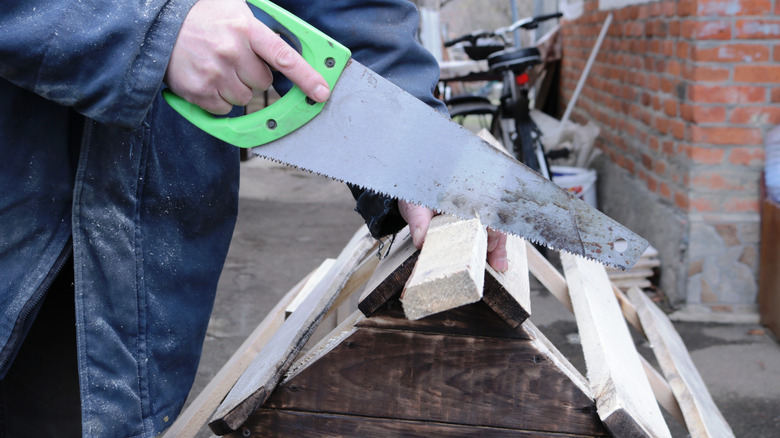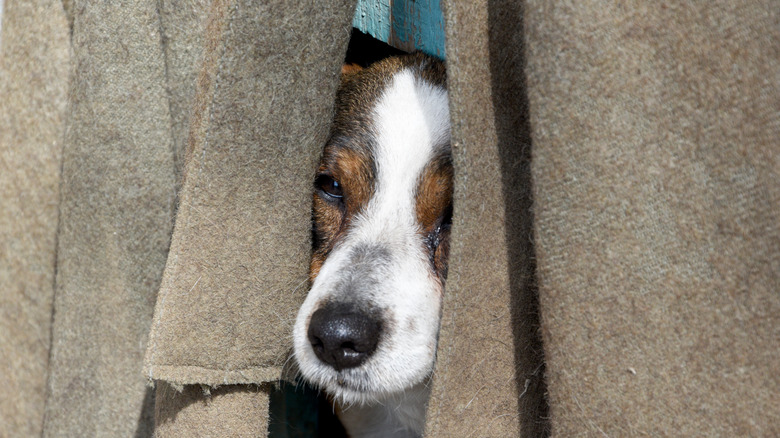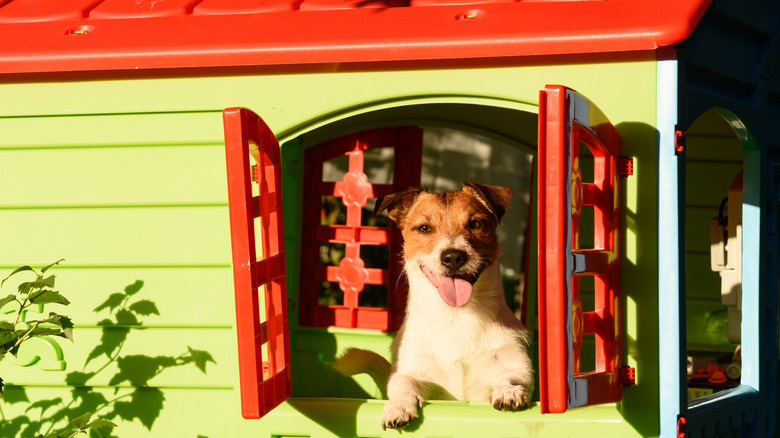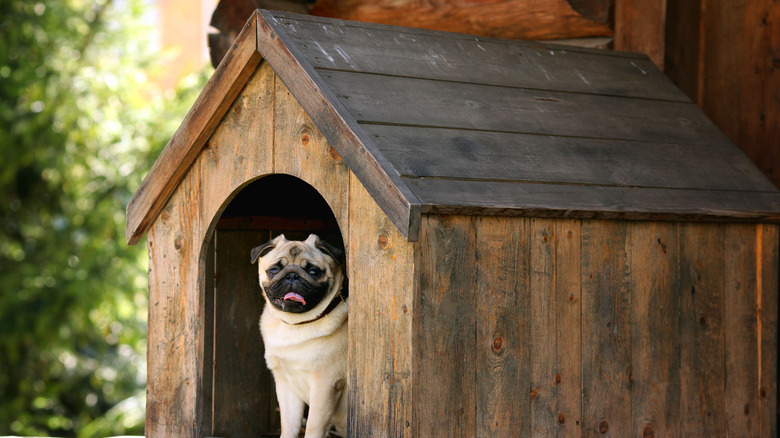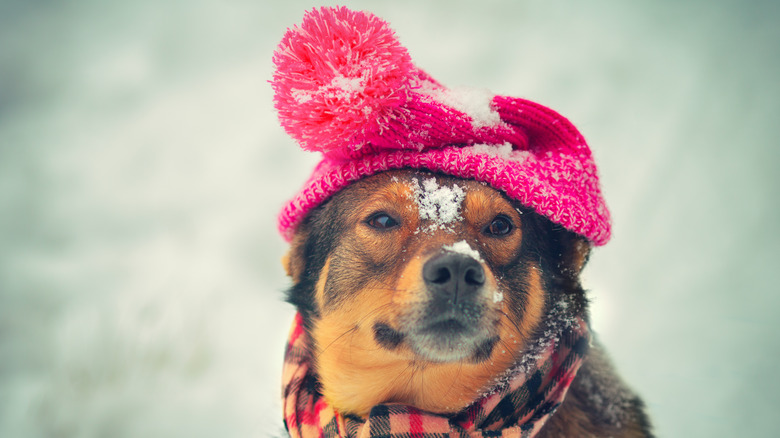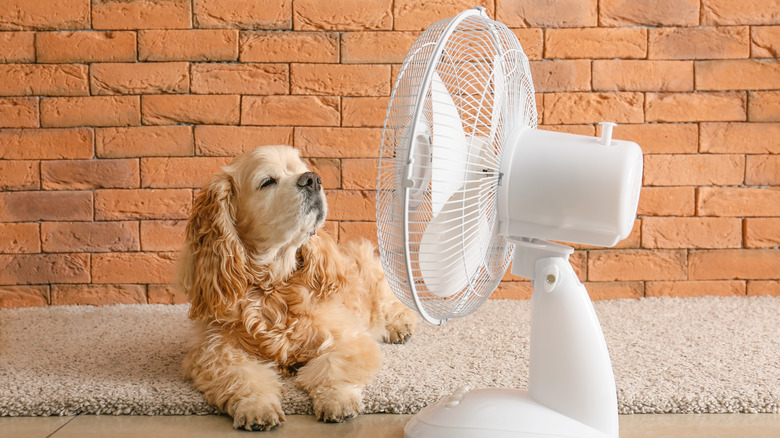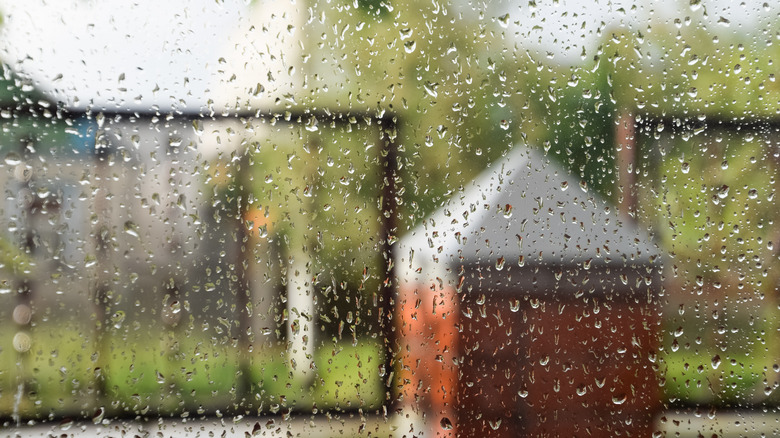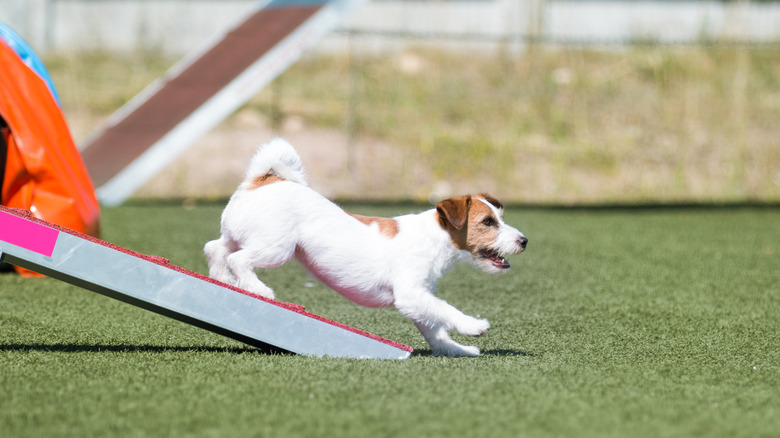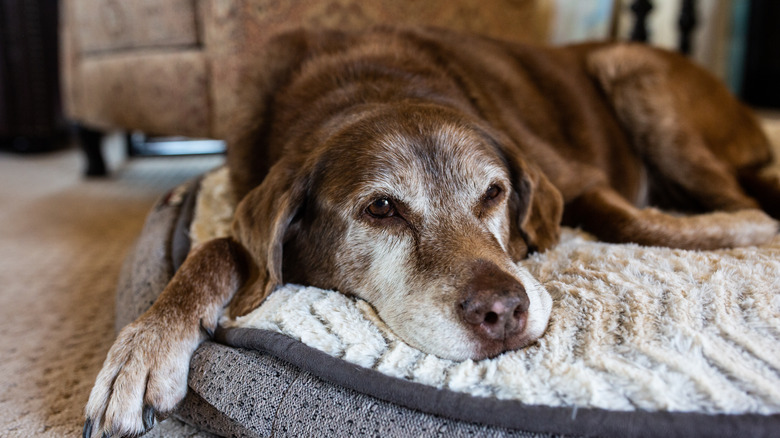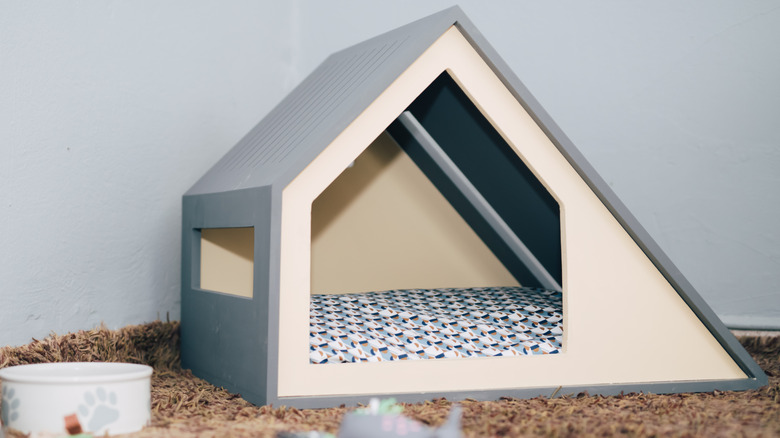What To Consider When Building Or Buying A Dog House
We may receive a commission on purchases made from links.
If you're a dog lover, you'll want to give your furry companion the best home possible. A dog house is both aesthetically pleasing and necessary for shelter. Like people, dogs seek shelter in bad weather conditions, per Rockstar Puppy. For those sizzling summer days, dogs may seek shade in a shed to stay away from the sun. An air-conditioned dog house may be just what they need to keep cool. For harsher winter temperatures, an insulated dog house can prevent the dog from getting hypothermia.
While a dog house is a nice amenity for a pet, you shouldn't keep your dog outside all day. Dogs who are elderly, ill, have short hair, or are thin may find it hard to fully adapt to an outdoor dog house (via Pet Meds). Your dog may feel bored and lonely if they're consistently outdoors since they need companionship, love, and affection from their owners. When designing or buying a dog house, there must be enough room for the dog to stand up and move around and proper ventilation (via PawPaw Pet Health Insurance). Consider the following tips when deciding on a dog house.
Make sure the size is correct
Finding the correct dog house size is essential. According to Classy Pet Shop, too small of a dog house could be uncomfortable for the dog, while a dog house that's too large prevents heat retention. While some people may purchase a dog house based on dog weight, it's not the best idea because dog weights fluctuate, and each breed has a different build.
Pet owners with tall breeds like Doberman Pinchers and Greyhounds need to buy or build a dog house big enough for the dog to turn around and lie down (via CallingAllDogs). Short and small dogs do well with smaller dog houses. The dog house door height shouldn't be less than ¾ of the dog's measurements from shoulder to the ground. The width and length of the dog house should be no larger than ¼ of the dog's size from the nose to the end of its body. The height should be at least ¼ taller than the dog's head to its toes.
Build a roof
Not only does a roof provide style for a dog house, but it also protects against rain and other harsh weather conditions. You can make a waterproof gable roof with lumber, per DoItYourself. First, take a ridge board and mark where to place the pieces of lumber. Saw even pieces to nail into the ridge board as the skeleton of the roof. Wood screws will secure the rafters onto the ridge board and wall frames. Place a plywood sheet on top of the rafters and place tar paper on the plywood sheet with nails. The roof will be shingled from the bottom up.
Want to try something different when making a dog house roof? Create a dog house roof with succulents (via Hallmark Channel on YouTube). For a small dog house, gather at least six pieces of wood with measurements would be ¾ inches by 3 ½ inches. Glue the pieces of wood on the roof with wood glue. Use a nail gun to secure the pieces together. Once the wood pieces are secure, use a staple gun to attach the roofing felt. Place chicken wire on top of the roofing felt and secure it with staples. Then, place small succulents inside the chicken wire holes. You can use wire cutters to make wider holes for larger succulents.
Design a curtain door
A curtain door may be the extra touch that your dog needs for their house. You can make a dog house curtain with a few sheets of PVC vinyl, per Dog House Times on YouTube. First, measure the length and width of the dog house's doorway. Cut two pieces of PVC vinyl that measure an extra inch or two of the doorway's measurements to give leeway. Since one piece of the vinyl may curve inward, place it on top of the flatter piece of vinyl.
For each vinyl piece, leave about one inch of space on top so as not to cut off the strips. Use a felt tip marker to mark how many strips you need to cut. Once you label everything and cut the strips evenly, drill holes into a piece of a garage weather strip through the two pieces of vinyl. Then, place the garage weather strip above the dog house door. Once the nails are halfway in, drill them fully into the top part of the dog house door. You can purchase this Plastic Vinyl Strip Curtain For DIY Pet Door from Resilia to get started with the project.
Windows or no windows?
Dogs love looking through windows to catch a glimpse of small animals like squirrels and rabbits they dream of chasing. While constructing windows in your dog house is practical and stylish, they can become dirty over time, per Mr Pet Fashion. Dogs love to press their wet noses and put their muddy paws all over windows, which makes it a pain for their owners to clean. Windows also don't provide a strong barrier against winter weather like solid dog house walls.
Windows in the dog house won't block heat unless you use handmade curtains to shield against sunlight. To keep a dog cool, pet owners should place the dog house under a shady area in the backyard. Instead of using windows for the dog house, invest in transparent doors. Transparent doors will keep the wind at bay, and dogs can still look out of them. It's up to the pet owner to decide what's best to use.
Decide on the material
A dog house should feature durable materials that are insulating, easy to work with, strong, and affordable, per Hepper. Some pet owners prefer making their dog house out of plastic. While plastic dog houses come in a variety of colors and are inexpensive, it's not the best for warmth due to lack of insulation. Concrete dog houses are a great permanent option, but the flooring may be too cold for the dog to lie on during winter. With concrete dog houses, it's best to place warm bedding on the floor of the dog house. Fiberglass is another option when making dog houses. It's well-insulated but hard to cut when fitting to size. Don't neglect wearing protective eye gear when sawing parts of the fiberglass. Brick dog houses are sturdy, well-insulated, and waterproof. The downside to brick houses is that laying bricks down can be challenging, and you may need a professional.
Wood is the best option when making a dog house because it's easy to cut and lightweight. However, protect it with varnish to prevent the wood from rotting. Wood is preferred over metal and plastic because the material doesn't absorb too much heat and cold (via Dog). Find wood without toxic substances in the stains or paints. Smooth down any sharp or rough edges to prevent your dog from getting splinters on its paws.
Keep warm in the winter
For the wintertime, make sure your dog stays warm and cozy in their dog house. It's best to find hypoallergenic bedding that won't attract fleas, per Daily Paws. To make sure your dog house is safe, cover any electrical cords and keep them away from dogs. Place the dog house in a spot in the backyard that's guaranteed to reach the sun, so it'll stay as warm as possible. Painting the dog house a dark color allows heat to be absorbed and remain warm.
Another tip is to install a heavy vinyl flap above the door to trap heat in the dog house. The vinyl flap will block out wind, rain, and snow. You can also raise the house legs to allow air to flow beneath the ground to keep cool during the summer. Placing hay or straw underneath the house makes it warm during the winter. Another way to keep the dog house warm is to add a portable heating pad inside the house. You can install a small furnace on the wall or ceiling to keep warm. Alternatively, go the natural route by installing solar panels on top of the dog house roof to generate heat.
Keep cool in the summer
Like people, dogs can suffer heat strokes and dehydration during the summertime. Is there a way to combat dogs from becoming ill this time of year? You can keep your dog cool during the summer by placing the houses in a shady spot, per Daily Paws. You can also paint the roof of the dog house a light color to prevent heat absorption from the sun. Add windows to the dog house and open them during the scorching summer months.
In addition, you can place frozen water bottles around the dog house or give your dog ice to gnaw on. Another way to remain cool in the summer is to put a cooling mat or pad inside the dog house for your furry companion to rest. Change your dog's bedding by finding a dog bed with a cotton or linen bottom instead of fleece or flannel. These materials won't trap body heat on warm days.
Ensure it's waterproof
No one likes the smell of a wet dog! You can waterproof your dog's house in a few simple steps. According to Waterproof Expert, all you need to seal a roof is tar paper, roofing shingles, and vinyl siding. Before getting started, try to find a suitable location for the dog house. A solid foundation to dig out dirt to lay down concrete or a steel frame foundation may be plausible. Bricks should be placed on top of the steel frame foundation to prevent the dog house from sinking into the ground.
You can seal the roof by placing tar paper on top. Tar paper combines regular paper with tar or fiberglass with tar. Get started on shingling by beginning from the bottom of the roof and working up to the top by using a staple gun to secure all shingle pieces. Tape, staple, or glue vinyl siding onto the inside of the dog house walls to prevent heavy gusts of wind from destroying the structure. For those nooks and crannies that need sealing, purchase rubberized liquid sealant to cover open parts. Not only does liquid sealant cover up unsightly areas, but it also silences the sound of winds, storms, and other disruptive weather noises.
Be savvy about costs
Before diving headfirst into a dog house project, get smart about costs. Paying for poor-quality materials or kits will affect your dog's quality of life. A contractor cost for a DIY kit is about $310 while building a dog house by yourself costs around $120, per DIY or Not. If you want to go a little fancy, make a wood-raised panel flooring dog house, which runs for about $125 or $185 for a professional contractor to do the work. Precut parts from the kit should be sorted and assembled with fasteners to complete the project, which takes time and effort.
Typical costs for dog houses range from $70 to $470 (via CostHelper). Wooden dog houses cost about $170 on average. This elevated TRIXIE Natura Pitched Roof Dog House from Petco is ideal for most small dogs. Plastic dog houses can cost between $155 to $270. As an inexpensive model, this plastic Suncast Outdoor Dog House With Door from Amazon may be just what your dog needs. Of course, you can always go the deluxe route and find a dog house with patios and hinged roofs for close to $4,500. Additional items like fans and heating systems for dog houses range from $50 to $150.
Stay accessible with ramps
Dogs with disabilities may need a ramp to navigate in and out of their dog house. You can build a ramp with pieces of lumber, according to the Family Handyman on YouTube. Cut the correct amount of lumber for the project with a drill saw. Measure out arcs on the lumber and cut out the rounded pieces of wood with an electrical saw. Use a drill to nail in four pieces of lumber to assemble the base.
Create the ramp by using a drill to nail the arched pieces of lumber on either side of the base lumber. Fasten the hinge to the base with nails. Round off each end of the wooden legs so the ramp can stand. Add two blocks of wood to the underside of the ramp on either side. The legs will have drilled holes and fasten onto either side of the ramp with screws and nails through the wood blocks. Use a staple gun to staple a carpet on top of the ramp for added traction. If you're not a fan of constructing a ramp out of lumber, you can also purchase a Step Ramp For Dogs on Doggo Ramps to ensure accessibility for your dog house.
Don't forget bedding
Bedding is essential for your dog house. It protects the floor of the dog house from getting scratched or scuffed, and you can use a good blanket, sheet, or linen towel for several years, per K9 of Mine. Some pet owners place rugs inside their dog house. While the rubberized backing prevents the rug from moving around, rugs aren't best for cold temperatures due to their lack of warmth. Orthopedic and heated dog beds are great alternatives.
Actual dog beds may be okay to place inside a dog house, but be aware of low-quality models where the material can fall apart. Seek dog beds made of waterproof material that won't get ruined. In addition to a bed, add cedar and pine chips to the floor to prevent fleas and other bugs from entering the dog house. Materials like hay and straw don't work well as bedding inside a dog house. Hay and straw can be contaminated with bacteria and livestock diseases. A newspaper is an acceptable option for bedding inside the dog house. While ink may stain the skin and fur of the dog, the ink from newspapers is non-toxic. You can easily change out the newspaper, and it's easy to crumple and smooth out to place inside.
Model a dog house on an actual house
Want to make a unique dog house that looks like a mid-century modern home? The first step is to consider how big your modern dog house will be, per DIY Inspired. Then, gather a bundle of pinewood and pine plywood. Construct a bottom structure by measuring and cutting the pinewood to fit and build the skeleton structure of the roof's frame. Use a drill to nail in all points as you go. Make sure to construct an eight-degree angle with the pinewood where the point of the roof meets. Paint the roof structure with a dark stain.
The next step is to cut pinewood for the outside of the dog house with a drill saw. Use nails to hammer in spots. Then, paint ¾ of the outside of the house and living room walls white for a fresh and clean vibe. Nail walnut wood boards to cover one side of the front of the home for a realistic look. Cut artificial grass and use liquid glue to attach it around the dog house.
Construct a succulent garden with pine plywood for a stylish touch. You can paint the inside of the box brown to resemble dirt and the outside white to match the exterior color. Paint the trim of the roof white. For a final addition, place the remaining plywood on top of the roof and use light brown tiles to shingle the roof. Creating an outdoor home for your dog will enable a safe, comfortable, and inviting place for years to come.
